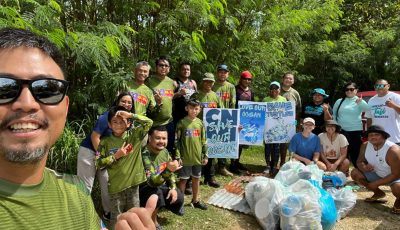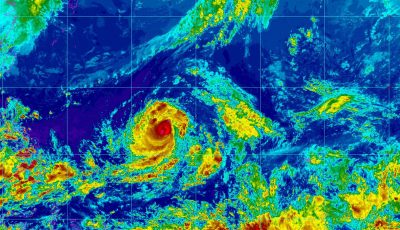Garapan storm drains tagged to warn vs polluting beach waters
Storm drains along Paseo de Marianas and the Garapan area have now been marked with “Do not dump” tags as part a greater interagency effort led by the Bureau of Environmental and Coastal Quality to prevent dumping of waste into the storm drains by people and businesses in the area.
According to BECQ watershed coordinator Kaitlin Mattos, any rain that falls between Garapan and Mt. Tapochao eventually go into the marked storm drains and then out into the ocean.

The Bureau of Environmental and Coastal Quality recently completed a storm drain marking and mural painting project with partners such as PDM Promoters and the Zoning Office—among others—to help prevent dumping of waste in the drains of the Garapan area. (Dennis B. Chan)
With the tags, she said, BECQ is trying to tell people not to throw their cigarette butts or used cooking oil in the drains, for example, and not to connect their sewer pipelines into the storm drains.
“You can see if you go up to Pau Pau or Wing Beach you’ll see coral reefs almost right away,” she said, comparing those beaches to Garapan where you mostly see sand, sea-grass, and algae. She blamed this on the runoff as well as pollution in the waters.
According to her, sediment that comes down from constructions sites and unpaved roads into the storm drains eventually “settles like a blanket” over the corals and keeps out the sunlight that corals need to grow and thrive.
“When you put too much nutrients [in the waters] it makes more algae grow than coral,” Mattos said.
She said that businesses that connect their sewer lines to the storm drains not only cause problems for the ecosystem but also risk the tourists and many small children and people out on the beaches every day.
Partners in the project include PDM Promoters, who help clean the area, and the Zoning Office, which help enforce compliance.
The Department of Public Works is responsible for cleaning the storm drains, while the Commonwealth Utilities Corp. helps identify and fix broken sewer lines that add to the pollution in the area.
Mattos said that customers who dispose of their toilet water into the storm drains instead of the sewerline may be reported to CUC .
She said they are trying to get the Marianas Visitors Authority on board as it has a “big influence on the businesses and tourists” in Garapan.
Yubert Alepuyo, zoning enforcement officer, who helped tag the drainages with his co-worker, Paul Lisua, said there are over 150 drainages in the Garapan area.
He said he is glad to represent his office in the water pollution prevention effort.



























